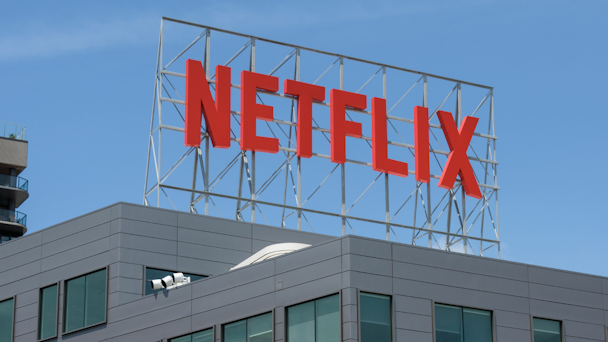Netflix Q2 subscribers & revenue jump as streamer doubles down on burgeoning ads business
The streaming giant adjusted its 2024 revenue growth forecast in response to strong Q2 numbers.

Netflix reported strong Q2 financials on Thursday / Adobe Stock
Netflix reported its second-quarter financial results on Thursday after the markets closed. The platform, which controls the largest share of the US streaming market, saw impressive growth during the last three months.
Revenues and earnings per share outpaced analysts’ projections, thanks in part to the company’s booming advertising business, which was launched in late 2022, and more stringent restrictions on password-sharing. Netflix’s growing presence in live sports is also driving eyeballs to the platform.
Explore frequently asked questions
Topline takeaways
Earnings per share were $4.88, surpassing the $4.74 per share projected by London Stock Exchange Group (LSEG), a leading financial markets research firm.
Revenue for the quarter came in at $9.56bn, above the company’s anticipated $9.49bn. It represents a nearly 14% year-over-year (YoY) lift.
Netflix recorded a net profit of $2.15bn in Q2, up 44%, and coming out ahead of estimates.
Meanwhile, 8.05 million new subscribers joined Netflix during the period, compared to 5.89 million net new subscribers during the same period last year.
The company’s total paid memberships have reached 274.4 million, according to estimates by StreetAccount, underscoring Netflix’s continued success in expanding its global subscriber base. This figure represents a significant increase from the roughly 270 million global subscribers recorded at the end of the first quarter, equating to 16% year-over-year growth.
However, the company continues to see subscriber growth rates slow in highly saturated markets, and evidence suggests that that trend will continue. Plus, Netflix is the only major streamer to record a decline in monthly usage among US adults, according to new data from Forrester.
“With so much consumer choice now in streaming, Netflix’s lead in the market will continue to shrink,” predicts Mike Proulx, vice-president and research director at Forrester.
But investors don’t appear to be deterred; Netflix’s stock is up nearly 40% this year.
Advertising as a key growth driver
While a lift in subscriber count drove revenue growth in Q2, Netflix’s nascent advertising business is playing an increasingly important role in the business.
The streamer was previously a subscription-only service, providing access to a vast, ad-free content library for a monthly fee. In 2022, however, the company’s subscriber growth began slowing. In response, Netflix jacked up prices for paying subscribers and cracked down on password sharing. Then, it turned to ads for the first time, debuting a cheaper, ad-supported plan. In the time since, it has retired its original Basic Plan, giving audiences the choice of a $6.99 per month ad-supported option, a $15.49 per month ad-free plan or a premium ad-free plan with higher resolution image and support for additional devices for $22.99 a month.
The expansion of its offerings have helped attract new customers, and drive revenue. In Q2 of this year, ads tier membership grew by 34% quarter-on-quarter. During an Upfront presentation in May, the company revealed that its ad-supported tier had reached 40 million global monthly active users, nearly doubling the figures reported just a few months prior.
Advertisement
Advertisement
And today, Netflix generates more ad revenue per viewer than any other streaming platform, according to recent data from Emarketer, although the gap between it and its closest rivals is closing. On the whole, however, the company’s ad revenues are on track to reach $1bn in 2024, Emarketer reports.
The company has also poured significant resources into developing its advertising business. It’s introducing QR code ads as well as a binge-watching incentive that rewards viewers with an ad-free episode after streaming three episodes back-to-back. Other new ad features, like ‘pause’ or ‘keep watching’ ads, have seen high rates of adoption, including from top brands like Coke, Ford and L'Oréal in the first two months of beta testing.
The platform is also expanding its sponsorship opportunities, as well as enhancing its campaign measurement capabilities with third-party verification provided by Integral Ad Science, DoubleVerify and Nielsen ONE in the US.
Netflix is currently working to develop an in-house adtech platform, to be tested in Canada in 2024 and launched to broader markets in 2025.
“Netflix’s commitment to its ads business is just beginning to show signs of scaling, meaning it’s headed in the right direction,” says Forrester’s Proulx. “That’s notable because ad revenue is a critical component to Netflix’s go-forward growth calculus. It’s because the company can’t rely on net paid subscriptions alone as the primary contributor to revenue growth because they aren’t trending upward.”
The promise of live sports
Netflix’s foray into live sports – long the remit of broadcast and cable TV – is also bolstering its bottom line. In January, the streamer inked a 10-year $5bn deal with WWE Raw. It’s also announced that Christmas day NFL games will be streamed on its platform for the next three years. The company’s expansion into live sports is expected to attract more advertisers in the coming months, ultimately driving revenue.
In conjunction with its growing ads business, Netflix’s live sports offerings could prove particularly lucrative, some experts predict.
“By combining its ad-supported model with live sports streaming, Netflix not only attracts a dedicated viewer base but also creates new monetization opportunities through dynamic ad placements and exclusive content,” says Sabya Das, president and chief operating officer at AI video company Magnifi. “This dual approach underscores Netflix’s ability to turn what I would have deemed a survival strategy to retain subscribers into a massive growth opportunity, solidifying itself as an entertainment hub and paving the way for innovation in personalized advertising and user experience.”
The success of other kinds of live programming, like The Roast of Tom Brady in early May – which garnered more eyeballs than any other live Netflix event to date – hints at a major opportunity for the company.
At the same time, Netflix’s core business of producing original shows and movies is still proving its worth. Among the most-viewed titles in the company’s history is Bridgerton, which unveiled its third season in May of this year. Q2 saw other big hits, too, including the psychological thriller Baby Reindeer and The Great Indian Kapil Show.
What’s next for Netflix?
In response to strong Q2 growth, Netflix has adjusted its revenue growth forecast for the year to 14%-15%, up from an earlier estimate of 13%-15%. For the full year, Netflix expects an operating margin of 26%, up from the previous estimate of 25%.
Suggested newsletters for you
As it plans to stop providing updates on quarterly subscriber numbers and average revenue per user, Netflix plans to focus on revenue and operating margin as primary financial metrics moving forward, with engagement – measured as time spent – serving as the best proxy for customer satisfaction. This shift reflects Netflix’s transition from a high-growth, low-profit business model to a slow-growth, high-profit model.
A key focus for the business in the coming months will be growing investment in its advertising practice. Along with the development of a proprietary adtech platform, Netflix is expanding its programmatic capabilities this summer with the help of partners like The Trade Desk, Magnite and Google Display & Video 360.
The company also plans to onboard measurement firm Barb; starting in September, the company will provide metrics for UK ad campaigns, delivering performance insights that will help advertisers calibrate their marketing efforts.
In a letter to investors Thursday, Netflix says it expects to reach critical ad subscriber scale across its markets by 2025. Although the company doesn’t advertising to account for a majority of its revenue in 2024 or 2025, it’s taking an optimistic view of the long-term.
“We’re very pleased with how we’re scaling our ads business,” said Spencer Neumann, the company’s chief financial officer, on a call with investors Thursday. “We’ve been primarily focused on on scaling reach, but if you think about even just the revenue portion of ads, it is growing nicely. It just happens to be growing off of a relatively small base, because we’re … only 18 months into ads. [It] just takes some time. So we’re scaling well through reach, through engagement, through growing inventory. And that represents opportunity for us over a multi-year trajectory to have a big and increasing revenue and profit impact on the business.”
Outside of its ads business, Netflix plans to build on its original content by leaning deeper into gaming this year. Starting this month, the company will push out a new game each month, many of which will be based on popular Netflix titles like Selling Sunset, Squid Game and Emily in Paris.
The platform is in the midst of reinventing its home screen interface, with plans to introduce a ‘My Netflix’ section – which is already available on mobile – to the big screen, highlighting content that the user has recently watched or saved.
Netflix’s stock saw a slight dip in after-hours trading, with shares dropping to $634.40, down 1.34%. Still, the company remains well-positioned for continued success as it adapts its strategies to the changing media landscape.
For more, sign up for The Drum’s daily newsletter here.
